Butter warmer is a distinctive kitchen essential for melting butter without overcooking or curdling the ingredient. While folks also use a microwave or a pan to heat the butter, choosing the wrong temperature or overheating it can cause problems. And, with numerous butter warmer types available, you can use it for fondue, melting chocolate, and reheating liquid foods like soups or sauces.
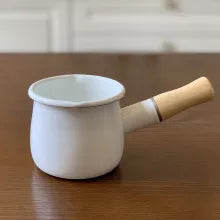
Butter warmer helps heat butter and keep it melted at the table, preserving the flavor, temperature, and delicacy. Besides, you can also use the butter warmer to melt chocolate, reheat small amounts of liquid food, warm milk, and other purposes. These melt pots are available in different materials, sizes, and induction-compatible options.
A butter warmer adds flavor to every bite, from cooking, baking, and sauteing to butter dips during the meals. The sweet-looking little pot adds great value to your kitchen, while the candle-lit table tops are pure beauty. So let’s explore more about this butter melting must-have for your kitchen.
What is a Butter Warmer?
Looking at a butter warmer, you can say it looks like a mini saucepan. Using a butter warmer made from the best heat-conducting material helps melt butter quickly. Butter warmers are available in different sizes and materials, with the usual size below one-quart capacity. This is a good size if you need to melt butter for lobster serving or mashed potatoes. However, you can choose larger utensils if you need to warm more butter. Alternatively, you can also use a butter warmer to melt caramel and chocolate.
Why do You Need a Butter Warmer?
That’s a good question. While melted butter is a wonderful ingredient, a butter warmer enables you to attain the perfect flavor, creaminess, and richness in every meal. The only thing needed is a dedicated utensil for it. For those who don’t liquefy butter often, the warmer can heat milk for the morning coffee or tea or when quick warming of a small quantity is required. This is just one of its many adorable uses as it saves your time and energy.
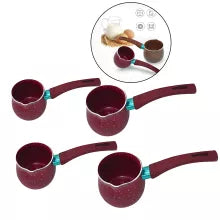
“But if I need to melt butter, I can always use the microwave.” If that’s what you are thinking, you aren’t wrong. Only that a warmer makes the process less messy and more efficient. And you can use it to melt the butter lightly without burning or scorching it. Plus, a warmer keeps the butter melted for long on the dining table, particularly for lobster or other dishes that you love eating by dipping in melted butter.
Interested in buying one? You have come to the right place. Learn how to select the right one with this quick buying guide right here.
Butter Warmer Buying Guide
To find the best butter warmer, you should consider the following factors:
- Cleaning: Ever thought of this aspect while buying utensils? Well! That’s essential because the cleanliness of a pan significantly impacts the taste, delicacy, and structure of everything you cook in it. For butter warmers, the ones made of stainless steel are easier to clean and maintain than others. Moreover, most kitchen products are dishwasher safe, facilitating the cleaning job. Non-stick warmers stand true to their name and are easy to clean and maintain.
- Versatility: You aren’t going to buy a special warmer just to melt the butter if you only occasionally use that ingredient. However, that won’t be the case with your butter warmer. While selecting the material and size, make sure you choose the one you can use for other purposes.
For instance, you can use it to reheat liquid foods, melt chocolate, and do many more, as said earlier. And that’s what makes butter warmers a great add-on to your kitchen.
- Ease of Use: The shape, capacity, and handles make it a fantastic pot pan to have around in the kitchen.
For ease of use, buy the one with an ergonomic handle. Add grips, so you can move them around with much more comfort. And if you are dealing with liquid food, you need the one that makes pouring easy. Pick one with a spout.
In short, your butter warmer should be easily cleanable, usable, and serve multiple purposes. Besides, picking a lightweight butter warmer with dimensions that fit your kitchen space makes it a great choice. So, are you ready to buy your perfect butter melting pot?
Now there are numerous butter warmers available in the market. So, to help you choose a suitable one for your kitchen, here’s a quick overview of the different kinds of butter warmers available in the market.
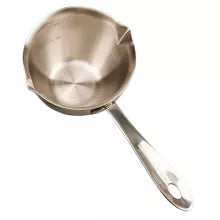
Different Types of Butter Warmers
Let’s start with an easy classification here. Based on the function and structure, butter warmers are classified into two types:
- Candle Warmer: Includes a tea light to generate the heat and a ceramic ramekin to contain the ingredient. A metal stand holds the ramekin. It melts and keeps the liquid food warm with the tea light’s flames. If you are looking for a butter warmer for a formal dining experience, this is a perfect choice. However, candle warmers are not stovetop-safe.
- Stovetop Warmer: What if you need a bigger warmer to melt a large amount of butter away from the table? A stovetop warmer with a handle is a good choice. Besides melting butter, you can use its larger vessel for other purposes like heating milk or other liquid foods.
Apart from the stainless steel warmers and the ceramic ones, many more material options are available for butter warmers. Here’s a brief classification of butter warmers based on the material.
- Stainless Steel Butter Warmers: How many stainless steel cooking utensils can you count in your kitchen? Probably a lot.
Stainless steel offers a smooth and non-reactive interior that keeps retaining flavor neutrality. In addition, it doesn’t react with the food’s chemical composition, especially when working with acidic ingredients.
But steel doesn’t come alone. Steel warmers with aluminum cladding at the bottom ensure even distribution of heat. And you will also see this combination in all induction-compatible butter warmers.
- Ceramic Butter Warmers: Aren’t those ceramic bowls in your kitchen pretty? Don’t have any? Well, you can add this attractive beauty to your collection.
Ceramic is another common, safe, and eco-friendly material used in kitchen utensils. Usually, ceramic is used in ramekins of candle warmers that stand on the top of a metal frame with a tea light beneath.
Ceramic’s ability to distribute the heat evenly and keep the butter warm for a long time makes it an ideal choice to be placed on the dining table for butter dips.
- Yet another ceramic material, porcelain, is also used in butter warmers.
- Non-stick Butter Warmers: When it comes to easy cleaning, non-stick remains the undefeated hero. A non-stick coating on the inner side helps food release smoothly. Plus, it makes cleaning the cookware much easier.
And if you are looking for a non-stick butter warmer, look for one made with aluminum for even and fast heating.
- Glass Butter Warmers: Imagine having a glass pot for melting butter or warming liquid in your kitchen! It not just serves the heating purpose but also adds an aesthetic appeal. And if you are worried about strength and durability, the thick borosilicate glass provides an explosion-proof design. Besides, the heat-resistant glass is also non-stick, making it easy to clean.
And that’s not all. You can find more material choices for butter warmers in the market, such as bamboo, melamine, chrome, and china, among others.
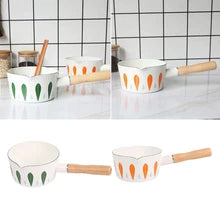
Finding the Right Butter Warmer Size
What do you need a butter warmer for? Is it to melt a few ounces to be kept on the dining table throughout the meal or heat more to add a dash of it to a dish? Usually, you will find butter warmers that can hold liquid up to 1 quart. However, you can also find warmers (or saucier pans) as big as 4 quarts capacity.
The smaller ones (3 to 5 ounces) are usually candle warmers. You can keep these warmers with ceramic ramekins and a tea light to serve as butter dips for seafood. From 12 ounces to 4 quarts, the bigger ones are available as stovetop butter warmers.
It isn’t a rule to buy only one, is it? You can have an assortment of size variations to serve multiple purposes while dining.
Other Uses of Butter Warmer
As already mentioned, butter warmers aren’t just to melt butter for a meal. Apart from others mentioned above in the article, there are some more applications of a butter warmer as briefed below:
- Make Chhonk (tempering spices): In South Asian cooking, the chhonk involves toasting spices in oil or clarified butter. It adds extra richness and flavor to a dish, and a small butter warmer is a perfect size to prepare a chhonk.
- Warm Syrup: Fond of eating pancakes in the morning? And if you love eating them with warm syrup, you don’t need the microwave for this small job. Get a butter warmer and heat the amount you need for your morning meal.
- Heat Leftovers: At times, you might have been heating leftovers from dinner in a big pan. Doesn’t that feel like too much work heating and cleaning the cookware? A small butter warmer solves this problem, giving you the right cookware to heat leftovers for a single serving.
In short, when you are buying a butter warmer, you aren’t purchasing a pan to melt the butter but for many other small quantity heating jobs.
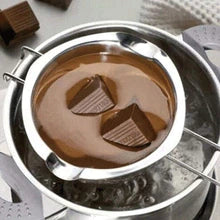
Now, Some Butter Warmer FAQs
While the article above gives plenty of details for buying and using a butter warmer, here’s some more information.
- Can you use butter warmers for fondue?
Yes. You can easily find fondue-style butter warmers to serve perfectly melted butter or chocolate for dinner or dessert. With the capacity of up to 5 ounces, candle warmers keep the butter liquefied throughout the meal without burning it. Plus, it’s an interesting way for individual servings of dips.
- Is butter warmer induction compatible?
Yes. Butter warmers made of aluminum and stainless steel are indeed induction compatible. However, you need to check the minimum diameter required for induction cookware.
- How long will it take to warm butter in a warmer?
Usually, a butter warmer will melt the butter in around 30-60 seconds, depending on the quantity of butter and heat.
- How do you keep the butter warm for seafood?
Candle warmers are the answer to this. Since a tealight candle can keep burning for hours, you can use them for a tableside serving of melted butter throughout the meal. Plus, ceramic ramekins retain the heat and keep the butter melted even after the candle goes off.
Some Tips for Using Butter Warmers
Before concluding, here are a few tips to help you make the most of your butter warmer.
- When using a stovetop butter warmer, never leave it unattended to avoid burning the liquid (or butter).
- Use candle warmers with caution as the open fire can cause fire accidents with careless movements. If you have long sleeves, roll them up before dining.
- Get small forks for dipping food into the ramekins.
- Consider buying a stovetop warmer with a spout for easy pouring.
- When hosting a party, keep extra butter on a stovetop warmer melted if the candle warmers run out of butter.
- You can use ceramic ramekins individually to serve oil blends or cold sauces when not melted butter.
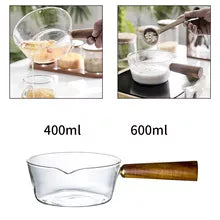
To conclude, with melted butter being a common ingredient in various dishes, butter warmer serves the ultimate purpose. While big pans or microwaves might cause burning or scorching, a warmer keeps the delicate flavor and warmth intact. Plus, you can get the required amount of butter melted by using the right size of the warmer in your kitchen. And why melt only butter when you can use a butter warmer for heating liquid foods, melting chocolate, and others likewise.
In short, a butter warmer is a must-have in every kitchen. So, go ahead and choose one that will suit your kitchen from the different materials and styles available.

